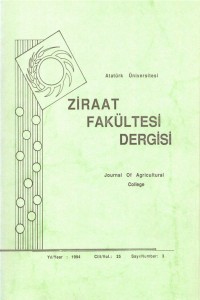BAZI YÖNTEMSEL FAKTÖRLER VE TOPRAK ÖZELLİKLERİNİN TOPRAKLARIN KIRILMA DEĞERİ ÜZERÎNE ETKİLERİ (1) / EFFECTS OF SOME METHODICAL FACTORS AND SOİL PROPERTİES ON THE MODULUS OF RUPTURE OF SOİLS
Abstract
ÖZET : Bu çalışma, bazı yöntemsel faktörlerin yapay toprak briketlerinin
kırılma değerinin ölçümü üzerine etkilerini ve bazı toprak özellikleri ile kırılma değeri
arasındaki ilişkileri incelemek amacıyla yapılmıştır.
Çalışmada, Atatürk Üniversitesi Ziraat Fakültesi Ziraat işletmesi arazisinin 12
farklı mahallinden 0-20 cm derinlikten alman toprak örnekleri kullanılmıştır.
Kırılma değeri, normal prosedür ile hazırlanan briketlerde 83-515 mbar ve
toprak macunu ile hazırlanan briketlerde ise 14322-27310 mbar olarak tespit edilmiştir
ve macunlaştırma ile 36-285 kat artmıştır.
Normal prosedür ve toprak macunu ile hazırlanan briketlerde, briket nem
içeriği İle tınlt bir toprakta log kırılma değeri arasında ve killi tınlı bir toprakta ise
kırılma değeri arasında doğrusal önemli (?<().01) negatif ilişkiler elde edilmiştir.
Kırma kuvveti uygulanma hızının 400 g/da olması 800 gld'ya nazaran, ölçülen
kırılma değerinde Önemli (P<0.05) bir azalmaya sebep olmuştur.
Normal prosedür ile hazırlanan toprak briketlerinde kırılma değeri ile büzülme
limiti arasında önemli (P<0.05) negatif bir ilişki elde edilmiştir. Fakat kırılma değeri
ile kil içeriği organik madde içeriği-briket hacım ağırlığı ve kil içeriği-agregat
stabilitesi-briket hacım ağırlığı arasında P<0.01 düzeyinde önemli çoklu ilişkiler
bulunmuştur.
Macunla hazırlanan toprak briketlerinde ise, kırılma değeri ile kil içeriği, mil
içeriği, likit limit, plastik limit, plastiklik indeksi, büzülme indeksi, doğrusal büzülme,
hacımsal büzülme arasında önemli (P<0.05) pozitif ilişkiler ve plastik limit/pF 2 nemi
oranı arasında önemli (P <0.05) negatif bir ilişki elde edilmiştir.
EFFECTS OF SOME METHODICAL FACTORS AND SOİL
PROPERTİES ON THE MODULUS OF RUPTURE OF SOİLS
SUMMARY : The purpose of this study was to determine the effects of
some methodical factors on the measurement of the modulus of rupture of artificial
soil briquets and the relations betvveen some soil properties and modulus of rupture.
Soil samples taken from the 0-20 cm depth of 12 different sites on the from of
the Agricultural Faculty of Atatürk University Erzurum w ere used in the work.
Modulus of rupture values were obtained between 83 and 515 mbar for the
briquets prepared with the normal procedure and between 14322 and 27310 mbar for
the briguets prepared with the puddled soil and increased as much as 36 to 285 times
upon puddling.
Linear negative relations were found between the moisture content of the
briquets and logarithm of the modulus of rupture value for a loam soil and between
the moisture content of the briquets and the modulus of rupture value for a clay loam
soil.
With 400 g/d application rate of breaking force it was obtained signifıcant
(P<0J)5) decrease in the modulus of rupture measured with compared to 800 gld.
For the soil briquets prepared with th enormal procedure it was found
signifıcant (P<0.05) negative relation between modulus of rupture and shrinkage
limit, but signifıcant (P<0.01) multiple relations between, modulus of rupture and
clay content-organik matter content- briquet bulk density, and between modulus of
rupture and clay conten briquet bulk density-aggregate stability.
For the briquets prepared with the puddled soil it was found signifıcant
positive relations between modulus of rupture and clay cocntent, between modulus of
rupture and sil t conten, between modulus of rupture and liquİd limit, between
modulus of rupture and plastic limit, between modulus of rupture and plasticityi
index, between modulus of rupture and shrinkage inde, between modulus of rupture
and linear shrinkage, between modulus of rupture and volumetric shrinkage, but
significant negative relation betvveen modulus of rupture and the ratio of plastic limit
pF 2 moisture content.
Keywords
Details
| Primary Language | tr;en |
|---|---|
| Journal Section | Makaleler |
| Authors | |
| Publication Date | December 12, 2010 |
| Published in Issue | Year 1994 Volume: 25 Issue: 3 |
Cite
Articles published in this journal are published under the Creative Commons International License (https://creativecommons.org/licenses/by-nc/4.0/). This allows the work to be copied and distributed in any medium or format provided that the original article is appropriately cited. However, the articles work cannot be used for commercial purposes.
https://creativecommons.org/licenses/by-nc/4.0/

